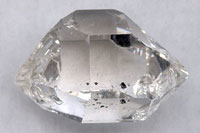
|
||||||
|
|
||||||
|
|
|
What is a Herkimer diamond?
A true diamond found in the rough is exactly that, a rough appearing glass - like stone. The true diamond must be painstakingly cut by man to give it smooth faces and a geometrical shape. On a hardness scale, a true diamond scores a ten. Herkimer Diamonds fall at a seven on the scale, giving the real diamond a close race. They are naturally faceted, each having eighteen faces and 2 points. The bedrock in which the crystals are found began forming approximately half a billion years ago in a shallow Cambrian Sea that lapped against the southern shores of the ancestral Adirondack Mountains (near the town of Herkimer, New York). The limy sediments (calcium magnesium carbonate) which slowly accumulated beneath the sea's salty waters were gradually compacted under the weight of thousands of feet of additional sediments, forming the rock strata Little Falls Dolostone. While still beneath the sea, water seeped through the pores of the rock often creating "vugs" by dissolving part of the rock. The collecting methods range from casually looking along the prospecting area, digging through the rubble energetically, using crowbars, sledgehammers and heavy chisels. The most popular tools are a 2 or 3 lb. crack hammer and a bull point chisel. The most popular method of prospecting for loose Herkimer Diamonds is by breaking them out of a single rock. Domed pocket mining in the table - layer of the rock is usually very rich with diamonds. Some pockets are known to contain thousands of diamonds. Pockets or cups can be up to six feet in diameter and usually no less than one foot. The dome-like tops of the pockets are often lined with small, white cubic-shaped dolomite crystal. Occasionally, the top will be beautiful black drusy quartz. Pockets containing diamond crystals are never the same either in size or in quality. Most pockets, as a rule, will contain diamond crystals of various sizes. Some pockets may contain large crystals ranging in size from four to eight inches long and three to four inches wide. Other pockets with medium sized crystals range in size from an inch and a half to three to four inches long and a half inch to two inches wide. Micro crystals are always found. As the crystals move up in size they tend to become less clear or more translucent than transparent. Some crystals contain anthraxolite or decayed plant life. The anthraxolite resembles bits of black coal within the crystals. A special discovery would be an enhydro crystal. These special specimen are crystals that contain a water bubble within it. An extremely lucky find is an enhydro which contains species of anthraxolite floating in the water bubble. Twins, doubles, clusters, tabulars, smokies, skeletals and phantom crystals are all valuable specimen found in pockets and are further described in the Lapidary Section. The most perfect crystals are usually those less than 1/2" long, but occasionally much larger crystals are found. Crystals commonly occur intertwined or clustered and often tiny, perfect crystals are attached to the backs of larger ones. An avid business of trading has developed among the multitudes of collectors, many of whom possess literally thousands of specimens. The most perfect crystals are often used as display pieces in unusually attractive necklaces, earrings, and bracelets. For more information visit www.herkimerdiamond.com
|
||||
|
|
||||||
